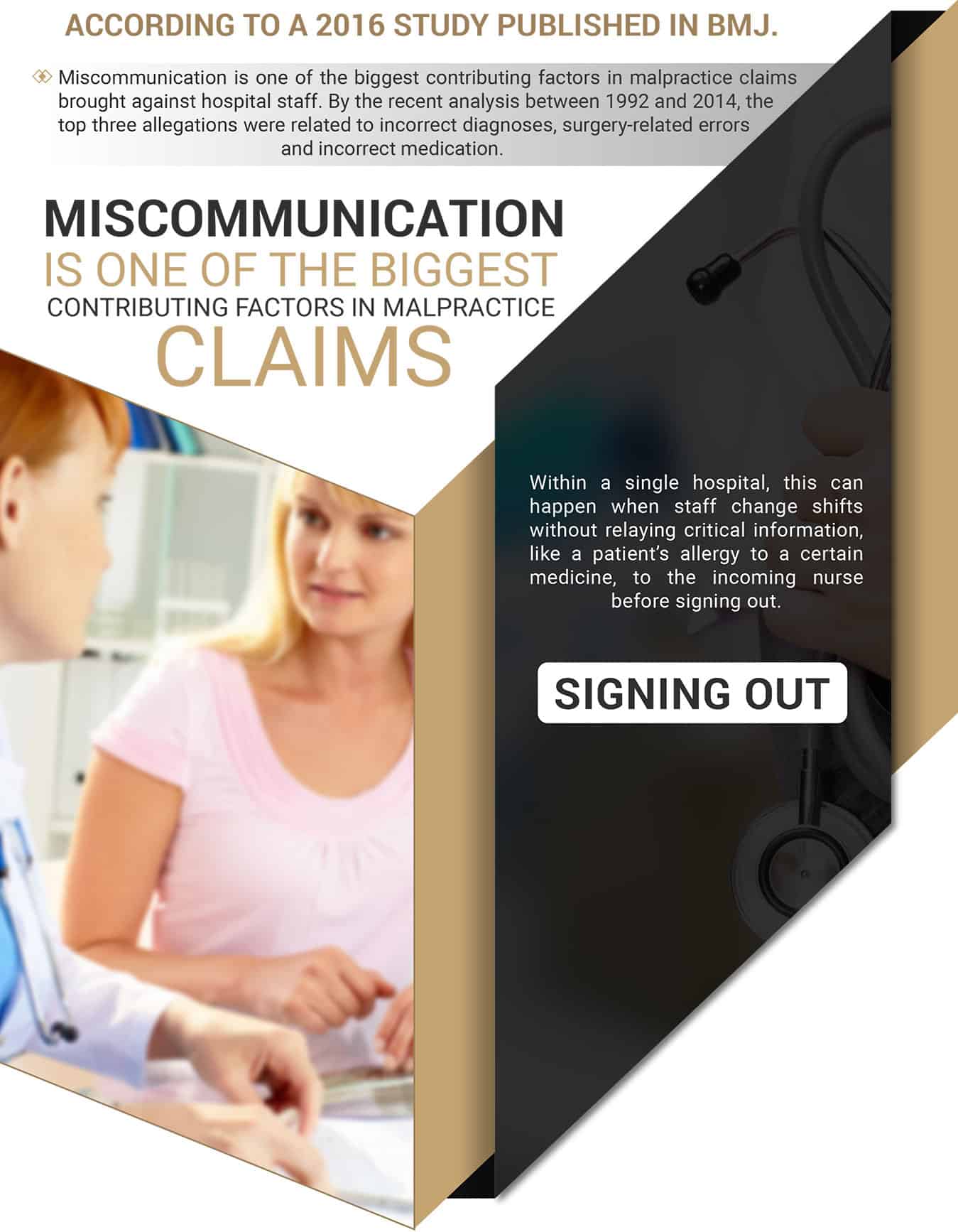HOW POOR
COMMUNICATION
LEADS TO MEDICAL MALPRACTICE
- It is a widely understood that poor coordination resulting from silos within the healthcare system reduce the quality of care and increase healthcare costs. But there is another serious, but often overlooked effect for physicians — the increased risk of malpractice allegations.
- Miscommunication is one of the biggest contributors to costly and dangerous medical mistakes. The number of deaths related to medical error at more than 250,000 each year.
- Part of the problem lies within the fragmented healthcare system in the United States, which hinders effective coordination between providers, insurers and patients.
HOW INTERNAL SILOS IN HEALTHCARE TEAMS AFFECT PATIENT SAFETY
![]() In a single hospital, where teams of physicians and nurses work together to treat patients, poor interpersonal relationships and ineffective communication often inhibit the effective coordination of care.
In a single hospital, where teams of physicians and nurses work together to treat patients, poor interpersonal relationships and ineffective communication often inhibit the effective coordination of care.


The Role of Communication Errors in Medical Malpractice
![]() Poor communication between medical staff is not just a problem for workplace morale: it can lead to patient injury and death. Indeed, medical error may be the third most common cause of death in the United States, behind cardiovascular disease and cancer. What’s worse, most of these mistakes go unreported, according to a 2016 study published in BMJ.
Poor communication between medical staff is not just a problem for workplace morale: it can lead to patient injury and death. Indeed, medical error may be the third most common cause of death in the United States, behind cardiovascular disease and cancer. What’s worse, most of these mistakes go unreported, according to a 2016 study published in BMJ.
ACCORDING TO A 2016 STUDY PUBLISHED IN BMJ.
![]() Miscommunication is one of the biggest contributing factors in malpractice claims brought against hospital staff. By the recent analysis between 1992 and 2014, the top three allegations were related to incorrect diagnoses, surgery-related errors and incorrect medication.
Miscommunication is one of the biggest contributing factors in malpractice claims brought against hospital staff. By the recent analysis between 1992 and 2014, the top three allegations were related to incorrect diagnoses, surgery-related errors and incorrect medication.
MISCOMMUNICATION IS ONE OF THE BIGGEST CONTRIBUTING FACTORS IN MALPRACTICE CLAIMS

Reducing risk through better coordination of care & communication
![]() A multifactorial problem needs a multifactorial solution. One key solution for breaking down the existing silos and improving patient outcomes is an integrated care model, which has received a lot of attention recently with the push toward value-based care under the Affordable Care Act.
A multifactorial problem needs a multifactorial solution. One key solution for breaking down the existing silos and improving patient outcomes is an integrated care model, which has received a lot of attention recently with the push toward value-based care under the Affordable Care Act.
![]() Models such as the Perioperative Surgical Home (PSH) which is pioneered by Dr. Zeev Kain tackle many of the inefficiencies and barriers to communication that results from the current fragmentation in the system. Another important component in radically transforming the problematic organizational structures in hospitals is greater transparency among various stakeholders. Online rating of hospitals and publications of specific comments are a step in the right direction. One fundamental change, however, is still needed.
Models such as the Perioperative Surgical Home (PSH) which is pioneered by Dr. Zeev Kain tackle many of the inefficiencies and barriers to communication that results from the current fragmentation in the system. Another important component in radically transforming the problematic organizational structures in hospitals is greater transparency among various stakeholders. Online rating of hospitals and publications of specific comments are a step in the right direction. One fundamental change, however, is still needed.


We need hospitals to publish more outcome data in a way that will enable the patient to make the right choices when they choose their doctor. The public should also be aware of the National Practitioner Data Bank (NPDB) where Medical Malpractice Payment Reports (MMPR) and Adverse Action Reports (AAR) reported on all practitioners by location (https://www.npdb.hrsa.gov/resources/npdbstats/npdbStatistics.jsp).




